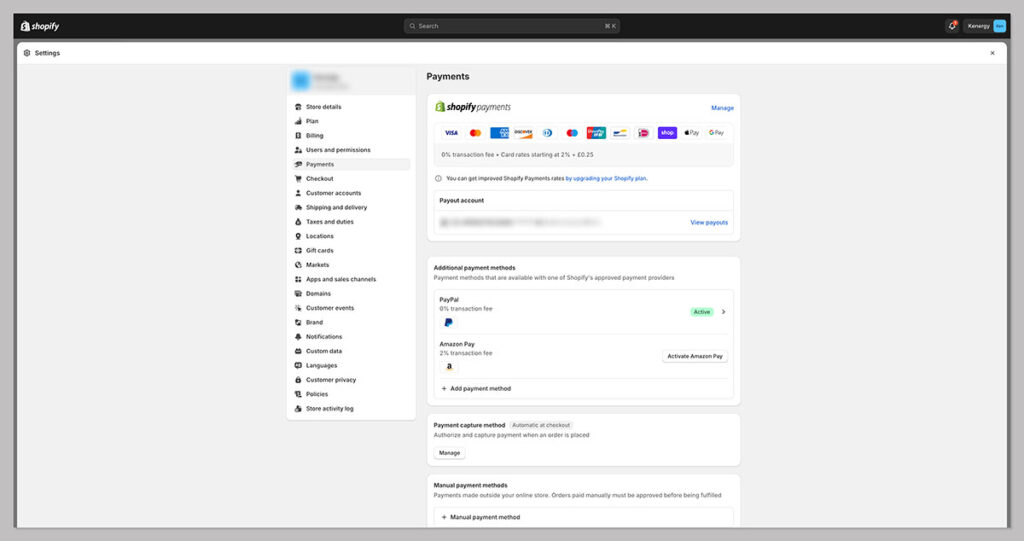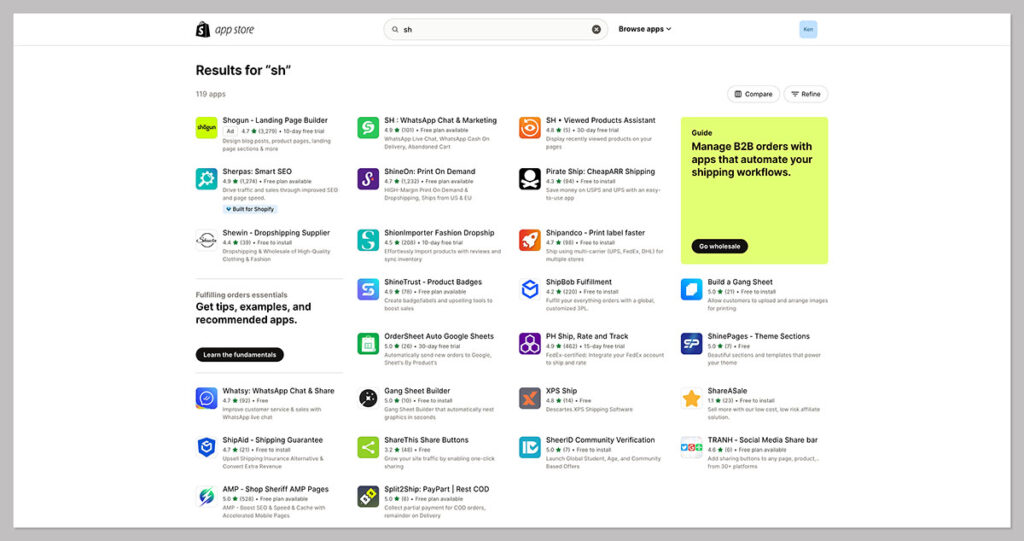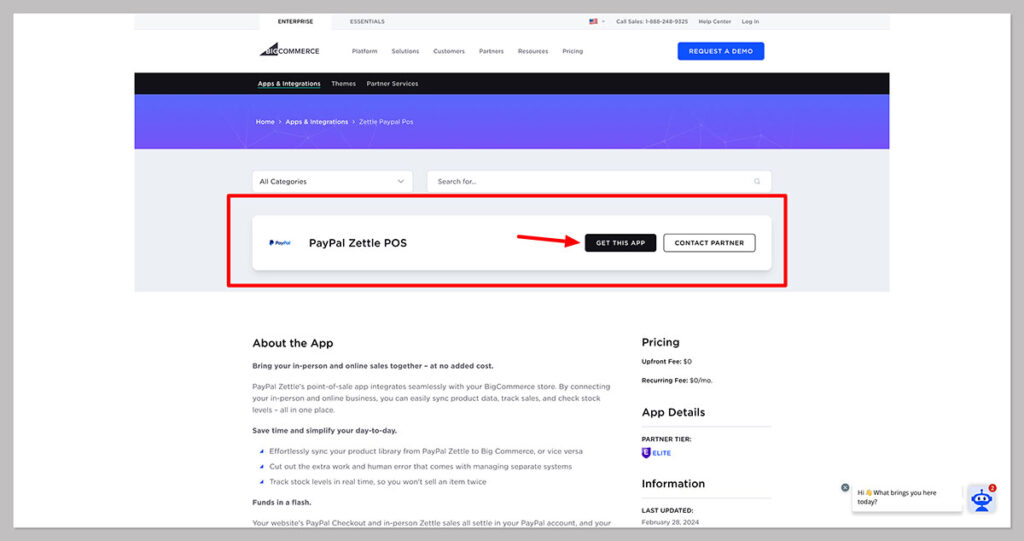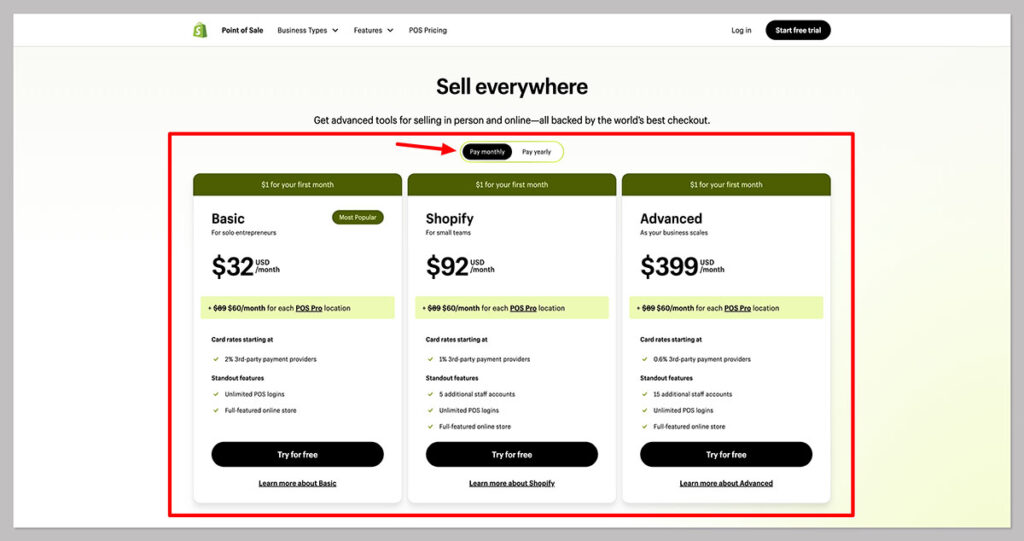BigCommerce vs Shopify: Which is really the best ecommerce platform?
It’s a battle I find particularly interesting, because both of these platforms are so similar on the surface.
They’re both powerful omnichannel sales tools, with options for headless commerce. Even the pricing structure is similar.
But when it comes to something as crucial as choosing the right ecommerce platform for your business, it’s important to dig a little deeper.
The only way to succeed in today’s ecommerce world is to ensure your platform has everything you need to not only run and optimize your store, but offer an exceptional customer experience.
I’ve gone behind the scenes extensively with both of these platforms, to discover which option offers the best value for money and functionality.
Quick Verdict: My Bottom Line
Shopify is my winner. But I can say that BigCommerce has become one of my favorite ecommerce platforms over the years.
However, while BigCommerce performs better than Shopify in terms of support and built-in features, Shopify still takes the win.
Shopify constantly delivers with exceptional flexibility, and a commitment to constantly delivering innovations.
BigCommerce vs Shopify: Key Takeaways
- Both BigCommerce and Shopify are scalable omnichannel platforms, with headless commerce options, and robust features.
- BigCommerce excels in terms of exceptional security and support. It also has better built-in SEO features already built in.
- Shopify benefits from a more flexible ecosystem, with a huge app marketplace for integrations, and more sales options.
- BigCommerce offers less value for money, as there’s no low-cost option (like Shopify Starter) available for beginners.
- Shopify has better templates for building your store, but BigCommerce offers more flexibility for editing your designs.
- Shopify is easier to use, particularly with the new Shopify Magic AI solution, which can generate product descriptions for you.
Ultimately, BigCommerce is best for businesses selling online only, with large inventories, such as B2B companies or wholesalers.
Shopify is better for B2C businesses who sell on a range of channels, including in brick-and-mortar (in-person) stores.
Pricing and Costs Comparison
One thing that makes it so hard to compare Shopify and BigCommerce in terms of value for money is that their core packages cost exactly the same.
Both BigCommerce and Shopify offer three core pricing plans, as well as a custom-priced enterprise package.
However, I think Shopify does have a bit of an edge with its Starter package (available for $5 per month), which is ideal for social selling.
Shopify Pricing Plans:

- Shopify Starter: $5 per month: Transaction fees of 5% plus 30 cents per transaction. Intended for social selling, with no store builder.
- Basic Shopify: $39 per month. Transaction fees of 2.9% plus 30 cents (online), with all the core store building features you need.
- Shopify: $105 per month. Transaction fees of 2.6% plus 30 cents (online) with more accounts for additional staff members.
- Advanced Shopify: $399 per month: Transaction fees of 2.4% plus 30 cents (online) with advanced reporting and customer support.
- Shopify Plus: Prices starting at $2000 per month, with custom transaction fees, and more advanced integration and design options.
There’s also the option to explore solutions like the Starter Shopify plan or Shopify Retail plan for companies with an in-person store.
BigCommerce Pricing Plans

- Standard: $39 per month: All the basic features with no transaction fees. Sell up to $50k annually, with unlimited staff accounts.
- Plus: $105 per month: No transaction fees, sell up to 180k annually, and more advanced features, like an abandoned cart saver.
- Pro: $399 per month: No transaction fees and you can sell up to $400k annually. Plus, there’s faceted search and a custom SSL.
- BigCommerce Enterprise: Custom pricing with more advanced API options and priority support.
Hidden Fees:
- Transaction fees: BigCommerce has no transaction fees on any of its plans, whereas Shopify charges different fees depending on the price you choose. You can keep your transaction fees low by using Shopify Payments, which just comes with credit card fees to consider.
- Sales volume restrictions: BigCommerce limits the sales you can make on each plan, and will automatically upgrade you to a higher plan if you pass the threshold.
- Apps and integrations: Both BigCommerce and Shopify offer access to integrations, which can come with an additional monthly fee.
Features and Functionality: An Overview
As I mentioned above, there’s a lot of overlap between BigCommerce and Shopify in terms of overall functionality.
BigCommerce used to be a go-to option for me, as it offered more built-in capabilities than virtually any other ecommerce platform.
However, Shopify is starting to get ahead, particularly with the introduction of new automation and AI tools, like Shopify Magic.
Both companies offer basic essential features as standard, such as shipping tools, an integrated SSL certificate to protect your store from threats, and omnichannel selling.
However, there are some core areas where they differ.
Payment Processing
Shopify has its own payment gateway, Shopify Payments, which offers exceptional credit card rates, particularly if you move to a higher-priced plan.
BigCommerce allows you to integrate your own payment processor, or take advantage of its partnership with Braintree (for lower rates).
If you want to add your own payment processor, BigCommerce supports 65 integrations, while Shopify offers over 100.
However, there are transaction fees to pay with a third-party payment processor on Shopify, which can eat into your profits.

Both tools will support multiple payment options and currencies, including user-friendly solutions like PayPal.
Themes and Design
Both Shopify and BigCommerce offer only a handful of free themes, but Shopify is a lot easier to use than BigCommerce when you’re designing a high-quality store.
Shopify’s themes are highly professional, responsive, and customizable.
BigCommerce makes it a little tougher to actually alter the components of your themes, and there aren’t as many “variations” to choose from.
Many of BigCommerce’s templates offer the exact same functionality, and a similar design, with just a different name.
Apps and Integrations
Both Shopify and BigCommerce offer great flexibility, with open APIs and integrations. However, I still think Shopify has the best app market, with literally hundreds of popular apps to choose from.
The app store is considerably larger than BigCommerce’s, and a lot of plugins are available for free.
While BigCommerce has a lot of sales features already built-in as standard, such as ratings and review solutions, real-time shipping quote tools, and unlimited staff accounts, Shopify can give you access to all of these features through the right apps.
Sales Features
BigCommerce has an incredible number of sales features already built into your store, such as options for creating countless variants for each product (600 compared to Shopify’s 100).
Both tools support the sale of services and physical products, and both are “omnichannel” platforms. Shopify and BigCommerce also have a fantastic shopping cart solution built-in.
However, Shopify does offer more freedom to expand across multiple channels. You can connect with Amazon and Ebay, as well as Snapchat and TikTok.
Plus, both tools have abandoned cart solutions, integrated shipping, and fulfillment solutions, and single page checkouts.
BigCommerce vs Shopify: Ease of Use and Customization
Ultimately, I’ve used both BigCommerce and Shopify extensively in the past, and find both platforms to offer excellent usability, even for beginners.
However, most users will find Shopify a little easier to use in general. BigCommerce’s features are intended for scaling companies with larger inventories.
Meanwhile, Shopify’s platform is a little less powerful, but you get a lot of guidance and support when it comes to setting up your store.
Adding products is as simple as just filling out a form for each item you want to sell. Plus, you get lots of “tips” along the way, to help you understand how different features work, and what you need to do to optimize your store.
BigCommerce leaves you to your own devices for the most part so there’s a larger learning curve. There are a lot of different “tabs” and components to get through when you’re adding products to your store.
While a lot of companies will appreciate the flexibility here, it does mean there’s more to learn if you’re a beginner.
BigCommerce also gives you a more hands-on experience when you’re customizing your store, but the templates and themes aren’t as comprehensive as those available from Shopify.
Since most of Shopify’s themes are highly tailored already, there’s less work to do when you’re updating your store.
On the plus side, BigCommerce does offer some great drag-and-drop tools for designing your storefront, and they have become a lot easier to use in recent years.
However, Shopify has an edge in terms of innovation. Shopify has introduced its AI tool (Shopify Magic) which can save you a lot of time on writing product descriptions.
You just need to describe the product you want to sell to the app, and the algorithm will do the rest for you. It’s even possible to change the tone of voice for your content.
BigCommerce vs Shopify: Marketing and Sales Channels
Both Shopify and BigCommerce know how important scalability is for a growing business, so they both offer support for a range of sales channels and marketing tools.
From a marketing perspective, BigCommerce has more built-in features, such as a one-click Google shopping integration, discount codes, and advanced reporting tools.
More expensive BigCommerce plans also include segmentation tools, and abandoned cart recovery emails.
Both tools also offer some basic email marketing functionality (though I’d recommend using an integration instead).
Shopify offers a lot of similar functionality, such as the ability to create discount codes and gift cards, and analytics for product performance and financial summaries.
I’d definitely recommend upgrading to the Advanced plan if you want more useful insights, however, as the reports are a lot more customizable and in-depth.
Screenshot?
SEO Capabilities
On the surface, the Search Engine Optimization (SEO) features offered by both companies are very similar. Both offer automatic sitemaps and customizable URLs and headers.
However, BigCommerce has a slight edge, with the ability to alter title tags and meta data for fantastic ranking potential.
Both platforms offer automatic 301 redirects, to help you keep each page working properly, and they’ll automatically prompt you with tips to improve your SEO.
However, BigCommerce does give you more functionality built-in to help with technical SEO support.
Sales Channels
As I said previously, both BigCommerce and Shopify are omnichannel platforms. You can connect your store with various marketplaces, including eBay, Amazon, and Etsy. BigCommerce also has a partnership with Walmart, so you can sell through that platform too.
Shopify, however, offers a lot more functionality for social selling, with TikTok and Instagram integrations, as well as Facebook selling options.
You also get Shopify POS Lite built into all Shopify plans, which allows for in-person selling.
Ecommerce Logistics: Shipping, Taxes, and Security
In terms of ecommerce logistics, there’s once again a lot of overlap between BigCommerce vs Shopify.
Both companies offer basic shipping tools which allow you to set shipping locations, amend rates based on order value or weight, and print your own shipping labels.
Shopify, however, has its own fulfillment network, as well as shipping partnerships, and the option to integrate with a wide range of dropshipping and third-party logistics networks.

Shopify and BigCommerce also offer access to tax management tools, which allow you to automatically calculate taxes and apply different tax rates for your customers, based on their location.
However, while Shopify has tax calculation built-in, you’ll need a third-party app for BigCommerce.
Inventory Management
When it comes to inventory management, BigCommerce offers an impressive and powerful system for managing stock levels, order trends, and insights.
It even allows you to sell all kinds of products without having to use third-party apps (including services and digital products).
Shopify allows you to automate inventory management with comprehensive tracking, and historic overviews of your sales.
Plus, if you’re using Shopify POS, you can sync your inventory across multiple locations and in-person stores.
Security
Security is critical when running an online store, but it’s something I see a lot of business owners overlooking.
The good news is that both Shopify and BigCommerce offer access to SSL certificates, as well as comprehensive PCI compliance.
BigCommerce offers multiple layers of strong security for all of the sites they host, and provides additional security measures, like perimeter or server-specific firewalls, and intrusion detection software, giving it a slight edge from a security perspective.
Customer Support and Community
Regardless of how simple your ecommerce platform might be to use; every store owner will need support at some point.
I do think BigCommerce has a slight edge in terms of overall customer support, as when you sign up for a free trial, you’ll receive a set-up call to help you.
Both Shopify and BigCommerce offer 24/7 chat, phone and email support, and they both have excellent knowledge bases where you can find guidance in the form of FAQs, articles, and documents.
However, the knowledge center offered by BigCommerce isn’t quite as comprehensive.
Shopify also gives you helpful prompts within the admin dashboard itself, with links directly to the knowledge center, which can help save you time looking for solutions.
In terms of community, Shopify has an edge again. There’s a fantastic forum where you can find additional support from your peers, as well as lots of communities online dedicated to Shopify.
Plus, you can choose to hire certified “Shopify Experts” directly through the Shopify Partner program if you need extra guidance.
I particularly love the “Inspiring Stories” section on Shopify, where you can find real-life stories from founders and business leaders who use the platform.
BigCommerce does offer something similar with its success stories “showcase” page, but many of the companies shown in this page don’t actually share their stories – they just link you to their website.
Dropshipping with BigCommere and Shopify
If you’re investing in the growing world of dropshipping, you shouldn’t have a problem with either Shopify or BigCommerce.
Both tools do integrate with dropshipping vendors, but for a small business starting an ecommerce store with a focus on dropshipping, Shopify is the best choice.
Shopify partners with DSers as it’s go-to solution for dropshipping. However, there are many similar dropshipping and print on demand vendors you can work with on the Shopify app store, including Printful and Printify.
Plus, Shopify has its own fulfillment network, to help your online business scale.
BigCommerce has a decent app marketplace with a number of great apps for product sourcing and managing online sales.
However, you can’t integrate with quite as many dropshipping companies with your BigCommerce store. Plus, BigCommerce doesn’t offer support for DSers, so if you want an affordable solution for AliExpress dropshipping, you’re out of luck.
In my opinion, Shopify seems to promote and support dropshipping solutions more extensively than BigCommerce.
This might be because BigCommerce is more focused on supporting larger B2B brands and wholesalers, than new online businesses.
BigCommerce vs Shopify: POS Solutions
If you want to take your ecommerce website offline, with an in-person store, then both BigCommerce and Shopify will allow you to do this.
However, there’s a big difference between how Shopify and BigCommerce approach in-store selling.
BigCommerce doesn’t have its own point of sale solution, much like competitors such as WordPress (WooCommerce), and Squarespace.
However, it does allow you to connect with a wide range of POS providers like Lightspeed or PayPal Zettle, to consistently sell offline. It also helps you manage all of your product catalogs in one place and sync inventory everywhere.

This makes BigCommerce a relatively good choice if your business needs include selling in-person. However, Shopify definitely has an edge in the in-store selling landscape, with its own dedicated point of sale software and hardware.
Most Shopify SaaS plans come with access to Shopify POS Lite, which gives you all the tools you need to managing your in-store shopping cart, inventory, and employees in one place.
On the Shopify Plus plan, you can also access Shopify POS Pro, or you can add this solution to any existing plan for $89 per month. This software comes with more advanced analytics and inventory management.

Not only does Shopify offers some fantastic tools for in-store selling in terms of software, but it produces highly innovative hardware too, such as the Shopify POS Go handheld payment processing device.
I’d definitely recommend Shopify as the go-to solution for in-person selling.
BigCommerce vs Shopify: Final Thoughts
Ultimately, Shopify is my preferred ecommerce platform for a handful of reasons. BigCommerce excels at offering built-in features, security, and customer support.
However, Shopify has a better online community, offers access to more sales channels, and benefits from a huge app market.
It’s also a more advanced platform overall, as the Shopify team are constantly integrating new tools to help you grow your business.
With Shopify, you can access everything from AI to dropshipping tools, and innovative offline selling solutions. If you’re looking for exceptional scale and flexibility, combined with ease of use, Shopify is the best choice.
Further reading 📚
FAQ
Shopify is known for it’s exceptional app ecosystem, ease of use, and fantastic range of ever-evolving sales channels. BigCommerce is more of an enterprise or large business focused solution with advanced features already built into the platform.
BigCommerce is slightly better than Shopify for SEO, as it offers access to comprehensive tools for changing alt tags and meta descriptions. However, both solutions offer search-friendly URLs, automatic site mapping, and basic features for optimizing your online store.
Absolutely, both Shopify and BigCommerce offer migration services which will help you transfer your store from one platform to another. However, you might find you need to spend a little more time updating your store after you import your data from Shopify to BigCommerce, as the features are more complex.





Comments 0 Responses